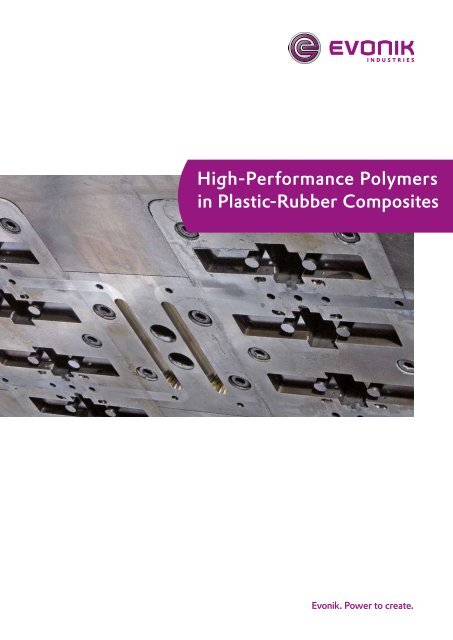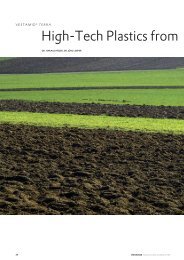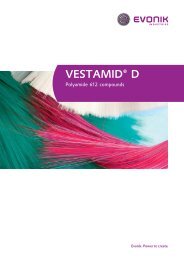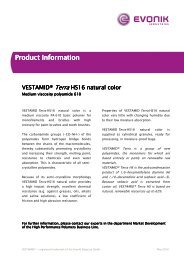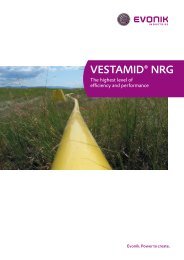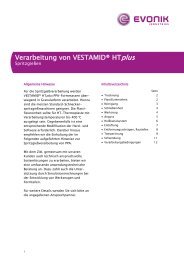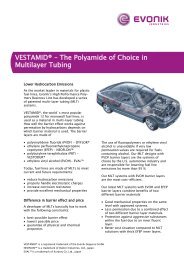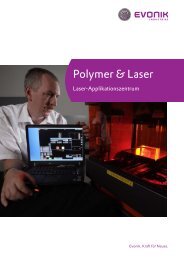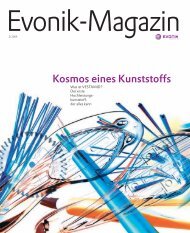High-Performance Polymers in Plastic-Rubber ... - VESTAMID
High-Performance Polymers in Plastic-Rubber ... - VESTAMID
High-Performance Polymers in Plastic-Rubber ... - VESTAMID
You also want an ePaper? Increase the reach of your titles
YUMPU automatically turns print PDFs into web optimized ePapers that Google loves.
Contents1 <strong>Plastic</strong>-<strong>Rubber</strong> Composites 41.1 _ Hard-Soft Composites ..........................................................................................................................................41.2 _Adhesion without Adhesives ............................................................................................................................... 52 Two Approaches to <strong>Plastic</strong>-<strong>Rubber</strong> Composites 62.1_ The Two-Stage Process .......................................................................................................................................62.2 _The One-Stage Process ........................................................................................................................................62.3 _Economy ..............................................................................................................................................................63 List of Compounds 84 Polyphenylene Ether VESTORAN ® 94.1 _Process<strong>in</strong>g ..........................................................................................................................................................114.2 _Chemical Resistance ...........................................................................................................................................115 Polyamides <strong>VESTAMID</strong> ® 145.1_ Polyphthalamide <strong>VESTAMID</strong> ® HTplus ................................................................................................................ 145.2_ Polyamide 612 <strong>VESTAMID</strong> ® D ............................................................................................................................ 156 Examples of <strong>Rubber</strong> Formulations 186.1_ SBR Formulation for K&K Composites with VESTORAN ® ................................................................................ 186.2_ NR/SBR Formulation for K&K Composites with VESTORAN ® .......................................................................... 196.3 _EPDM Formulation for K&K Composites with VESTORAN ® and <strong>VESTAMID</strong> ® DX9325 ..................................... 206.4 _XNBR Formulation for K&K Composites with <strong>VESTAMID</strong> ® D ........................................................................... 216.5 _HNBR Formulation for K&K Composites with <strong>VESTAMID</strong> ® D, <strong>VESTAMID</strong> ® HTplus .......................................... 226.6 _FKM Formulation for K&K Composites with <strong>VESTAMID</strong> ® D, <strong>VESTAMID</strong> ® HTplus ............................................. 226.7 _AEM Formulation for <strong>Plastic</strong>-<strong>Rubber</strong> Composites with <strong>VESTAMID</strong> ® D, <strong>VESTAMID</strong> ® HTplus ............................. 23
1 <strong>Plastic</strong>-<strong>Rubber</strong> CompositesThe <strong>High</strong> <strong>Performance</strong> <strong>Polymers</strong> Bus<strong>in</strong>ess L<strong>in</strong>e of Evonik manufacturesa l<strong>in</strong>e of compounds specially modified for the productionof adhesive-free plastic-rubber composites.This brochure describes the plastic-rubber composite process(K&K process) and the compounds available for it.Like all high-performance plastics from the <strong>High</strong> <strong>Performance</strong><strong>Polymers</strong> Bus<strong>in</strong>ess L<strong>in</strong>e, these compounds meet the highestquality standards. Our quality management system is certifiedaccord<strong>in</strong>g to ISO 9001:2000 and ISO/TS 16949:2002. Numerouscustomers have tested this quality management systemand confirmed its superiority.1.1 Hard-Soft CompositesWherever rubber components must be fastened or fixed, compositesconsist<strong>in</strong>g of a hard component and an elastomer performwell. They represent an important sector of the rubber <strong>in</strong>dustry.Such composites are found <strong>in</strong> a wide variety ofapplications, for example, as shock-absorb<strong>in</strong>g bear<strong>in</strong>gs <strong>in</strong> thechassis of motor vehicles, buffers or re<strong>in</strong>forced seals <strong>in</strong> eng<strong>in</strong>esand mach<strong>in</strong>es.Traditionally, hard components consisted of metalcomposites. To reduce weight, particularly <strong>in</strong> vehicles,more and more metal components are be<strong>in</strong>g replacedby suitable plastic parts wherever possible.This has two additional advantages: <strong>Plastic</strong>s do notcorrode and can be efficiently processed <strong>in</strong>to verycomplex mold<strong>in</strong>gs by <strong>in</strong>jection mold<strong>in</strong>g. However,they must be dimensionally stable at the usual vulcanizationtemperatures of 160–190°C. The manufactureof such complex parts from metal is very expensive.The use of plastics <strong>in</strong> the design of complexcomponents provides the designer and componentdeveloper with much greater latitude.For the long-term function of composites, particularlyunder dynamic stress, the adhesion between thehard component and the soft component of the compositeis an important criterion. It is usually achievedby adhesives. Comb<strong>in</strong>ations of all standard rubber typeswith most metals and simple plastics are possible.Besides additional process steps for apply<strong>in</strong>g theadhesives, protective measures aga<strong>in</strong>st emissions ofthe usual solvents and their environmentally correctdisposal are required.4
4 Polyphenylene Ether VESTORAN ® 9VESTORAN ® is the registered trademarkof Evonik for compounds based on poly-2,6-dimethyl-1,4-phenylene ether (PPE).The amorphous material has high heat deflectiontemperature. Mold<strong>in</strong>gs ofVESTORAN ® have very low mold shr<strong>in</strong>kageand warpage. VESTORAN ® is hotwater-resistant. The water absorption isvery low. It is resistant to alkalis and acidsbut less resistant to fats, oils and fuels.Section 4.2 provides details on chemicalresistance.Four VESTORAN ® grades are availablefor adhesive-free plastic-rubbercomposites:• VESTORAN ® 1900 natural and1900 black• VESTORAN ® 1900GF20 light ivoryand 1900GF20 blackThese grades can be comb<strong>in</strong>ed with SBRand SBR blends, such as NR/SBR; theSBR portion should be at least 20 wt%.These rubbers are to be crossl<strong>in</strong>ked withsulfur. Applications of such comb<strong>in</strong>ations<strong>in</strong>clude vibration bush<strong>in</strong>gs and shock absorbers<strong>in</strong> the chassis of motor vehicles.Comb<strong>in</strong>ations with EPDM compoundsthat are peroxidically crossl<strong>in</strong>ked performwell. Examples of applications are re<strong>in</strong>forcedprofiles and seals.Examples of SBR, NR/SBR and EPDMformulations are shown <strong>in</strong> Chapter 7.Figure 4Molecular structure of polyphenylene ether
Table 3: Properties of polyphenylene ether compounds for plastic-rubber compositesProperties Test method UnitVESTORAN ®1900Physical, thermal and mechanical propertiesDensity 23°C ISO 1183 g/cm 3 1.04 1.19Melt volume-flow rate (MVR) 300°C/21.6 kg ISO 1133 cm 3 /10 m<strong>in</strong> ca. 40 ca. 15Tensile test ISO 527-1/-2Stress at yield MPa 60Stra<strong>in</strong> at yield % 6Tensile strength MPa 110Stra<strong>in</strong> at break % >50 3Tensile modulus ISO 527-1/-2 MPa 2000 5600Flexural modulus ISO 178 MPa 2400 5700CHARPY impact strength* 23°C ISO 179/1eU kJ/m² 250 P 50 CCHARPY notched impact strength* 23°C ISO 179/1eA kJ/m² 25 C 12 CTemperature of deflection under load ISO 75-1/-2Method A 1.8 MPa °C 170 185Method B 0.45 MPa °C 190 190Vicat soften<strong>in</strong>g temperature ISO 306Method A 10 N °C 190 200Method B 50 N °C 185 190Flammability acc. UL94 0.8 mm ISO 60695 HB HB1.6 mm HB HBWater absorption 23°C, saturation ISO 62 % 0.4 0.4Process<strong>in</strong>g shr<strong>in</strong>kageDeterm<strong>in</strong>edon 2 mm<strong>in</strong> flow direction % approx. 0.9 0.5sheets with<strong>in</strong> transverse direction % approx. 0.8 0.6film gate atrim, moldtemperature80°CVESTORAN ®1900GF20Electrical PropertiesRelative permittivity 100 Hz IEC 60250 2.6 2.91 MHz 2.9 2.7Dissipation factor 100 Hz IEC 60250 8 • 10 -4 8 • 10 -41 MHz 16 • 10 -4 18 • 10 -4Electric strength K20/P50 IEC 60243-1 kV/mm 40 33Comparative track<strong>in</strong>g <strong>in</strong>dex IEC 60112Test solution A CTI 225 200100 drops value 200 175Volume resistivity IEC 60093 Ohm • m 10 13 10 13Surface resistance R OA IEC 60093 Ohm 10 14 10 13Electrolytic corrosion IEC 60426 Stage A1 A110
4.1 Process<strong>in</strong>g VESTORAN ®Pre-dry<strong>in</strong>gAlthough VESTORAN ® absorbs very littlemoisture, pre-dry<strong>in</strong>g <strong>in</strong> a circulat<strong>in</strong>g orvacuum dryer is extremely important.To prevent damage to the material, dry<strong>in</strong>gconditions should not exceed 110–120°Cfor 2 hours. The pre-dried granulatemust be <strong>in</strong>troduced hot <strong>in</strong>to the mach<strong>in</strong>ehopper. The dwell time of the melt <strong>in</strong> thecyl<strong>in</strong>der should be less than 5 m<strong>in</strong>utes.Mach<strong>in</strong>e parametersScrew: L/D ratio m<strong>in</strong>. 20:1, compres -s ion ratio 2:1 to 3:1Nozzle: Diameter greater than 3 mmInjection pressure: 800–1600 barHold<strong>in</strong>g pressure: 50–80% of <strong>in</strong>jectionpressureSpecific back pressure: 5–10 barTemperature sett<strong>in</strong>gs:Cyl<strong>in</strong>der: 280/300/320/320°CNozzle: 310°CMelt: 300–330°CThe melt<strong>in</strong>g temperature should not exceed340°C to prevent thermal damageto the PPE.MoldExternally heated hot runner systemsmust be used. Approximately 0.05 mmdeep vent<strong>in</strong>g channels should be placednear the weld<strong>in</strong>g l<strong>in</strong>es.Temperature sett<strong>in</strong>gs for separate manufactureof the mold<strong>in</strong>gs (two-stage process):VESTORAN ® 1900 80–90°CVESTORAN ® 1900GF20 130–140°CTemperature sett<strong>in</strong>gs for theone-stage process:VESTORAN ® 1900 180°CVESTORAN ® 1900GF20 180°CThe higher mold temperature <strong>in</strong> the onestageprocess enables the mold<strong>in</strong>g heat tobe utilized for a shorter vulcanization timeof the rubber component. An exhaust<strong>in</strong>gdevice above the <strong>in</strong>jection mold<strong>in</strong>g mach<strong>in</strong>eis strongly recommended.Handl<strong>in</strong>g VESTORAN ® mold<strong>in</strong>gs <strong>in</strong> thetwo-stage processWhen pre-molded components are usedfor the plastic-rubber composites, nomold release agents may be used. TheVESTORAN ® surfaces must be free ofgrease and dust. Intermediate storage ofthe mold<strong>in</strong>gs is done <strong>in</strong> the dark, for example,<strong>in</strong> black polyethylene bags. Furtherprocess<strong>in</strong>g with<strong>in</strong> two weeks is recommended.Contam<strong>in</strong>ated surfaces can becleaned by wip<strong>in</strong>g them off with toluene.11
4.2 Chemical Resistance of VESTORAN ®The stress crack<strong>in</strong>g susceptibility test accord<strong>in</strong>g to ISO 4599under the <strong>in</strong>fluence of different media is a criterion for chemicalresistance (bent strip test, 3.5% outer fiber stra<strong>in</strong> withbasic grades; 2.7% outer fiber stra<strong>in</strong> <strong>in</strong> the case of glassfiber-re<strong>in</strong>forced grades). The resistance is dependent ontemperature but also on the stress state of the test specimen.Therefore, we recommend us<strong>in</strong>g a test under field conditionsto determ<strong>in</strong>e whether the requirements are met.12
5 Polyamides <strong>VESTAMID</strong> ® Figure 5Evonik manufactures and sells various polyamide (PA) grades. The polyamide 612 products are named <strong>VESTAMID</strong> ® D, the polyphthalamide(PPA) grades are supplied under the trade name <strong>VESTAMID</strong> ® HTplus.5.1 Polyphthalamide<strong>VESTAMID</strong> ® HTplus<strong>VESTAMID</strong> ® HTplus belongs to the familyof polyphthalamide (PPA) polymers.Evonik have comb<strong>in</strong>ed high temperaturedurability, excellent chemical resistanceaga<strong>in</strong>st the most automotive fluids, andoutstand<strong>in</strong>g mechanical properties withthe flexibility of multiple process technologies.Our latest development exploitsthe high heat deflection temperature ofmore than 280°C and dimensional stabilityof <strong>VESTAMID</strong> ® HTplus, especially <strong>in</strong>the range of 120 to 140°C, and adds thespecial functionality of direct bond<strong>in</strong>g toa variety of elastomers. Compared withPA 66 and PA 612, <strong>VESTAMID</strong> ® HTplusfeatures also higher strength and stiffness,especially <strong>in</strong> contact with moisture,a high long-term heat resistance up to150°C, and a low tendency to creep.Due to higher heat deflection temperatureof PPA compared to PA 612 it is possibleto vulcanize also th<strong>in</strong> thermoplasticparts together with rubber up to 190°Cwithout any deformation of the plasticpart.For direct rubber bond<strong>in</strong>g threeheat- stabilized grades are available:• <strong>VESTAMID</strong> ® HTplus R1033 and R1133are 30% glass fiber-re<strong>in</strong>forced,• <strong>VESTAMID</strong> ® HTplus R1035 conta<strong>in</strong>s50% glass fibers.These compounds are especially formanu factur<strong>in</strong>g parts sub jected to hightemperature.Moleculare structure of polyphthalamideTable 5: Properties of <strong>VESTAMID</strong> ® HTplus compounds for plastic-rubber compositesProperty Test method Unit R1033 R1133 R1035Glass fiber content % 30 30 50Density 23°C ISO 1183 g/cm 3 1.43 1.40 1.64Tensile test ISO 527-1/-2Tensile strength MPa 180 140 260Stra<strong>in</strong> at break % 2.0 1.5 1.8Tensile modulus ISO 527-1/-2 MPa 11000 10500 17000CHARPY impact strength *ISO 179/1eU23°C kJ/m 2 45 C 29 C 70 C-40°C kJ/m 2 30 C 23 C 50 CCHARPY notchedISO 179/1eAimpact strength *23°C kJ/m 2 7 C 6 C 12 C-40°C kJ/m 2 7 C 6 C 12 CVicat soften<strong>in</strong>g temperature ISO 306Method A 10 N °C 308 300 308Method B 50 N °C 275 275 282Melt temperature °C 330-340 330-340 330-340Mold temperature °C 140-180 140-180 140-180*C = complete break14
5.2 Polyamide 612<strong>VESTAMID</strong> ® DCompounds are available <strong>in</strong> the D seriesspecifically for adhesive-free manufactureof plastic-rubber composites. As partiallycrystall<strong>in</strong>e materials, they feature excellentchemical resistance, particularly towardgreases, oils and fuels. Besides verygood slid<strong>in</strong>g friction properties, PA 612compounds show appreciably less waterabsorption than PA 6 or PA 66.Figure 6Molecular structure of polyamide 612Chemical resistanceThe chemical resistance of PA 612 is comparableto that of PA 12. Polyamide 612generally displays outstand<strong>in</strong>g resistanceto fuels, lubricants, greases, oils, andmost <strong>in</strong>dustrial solvents. Polar solventscan cause reversible swell<strong>in</strong>g, especiallyat elevated temperatures. This will generallybe connected with a drop <strong>in</strong> strength(plasticizer effect). In practice, the orig<strong>in</strong>alcharacteristics will be restored afterthe solvent has evaporated. Liquids thathave a particularly high aff<strong>in</strong>ity to the carbonamidegroups of the polyamides canact as solvents for PA 612 at higher temperatures.Examples are phenols, cresols,benzyl alcohol, and particular chlorohydrocarbons.Due to their low water absorption,PA 612 compounds exhibit verygood resistance to aqueous agents, suchas alkali solutions, sal<strong>in</strong>e solutions, andcleaners. Their resistance to aqueousacids is limited, depend<strong>in</strong>g on the temperature,time, and concentration. In general,concentrated acids will lead to a moreor less rapid drop <strong>in</strong> relative molar mass(embrittlement). Concentrated sulfuricacid and formic acid will dissolve PA 612.<strong>Rubber</strong> comb<strong>in</strong>ationsThe properties of the <strong>VESTAMID</strong> ® gradessuitable for plastic-rubber composites arelisted <strong>in</strong> Table 6. Compounds with differentglass fiber contents and, <strong>in</strong> somecases, with impact modification are available.For manufacture of oil-resistant andfuel-resistant seals and mold<strong>in</strong>gs, they canbe comb<strong>in</strong>ed with appropriate rubberblends, for example, based on XNBR rubber,partially saturated HNBR rubber andFPM rubber. Mold<strong>in</strong>gs for the two-stageplastic-rubber process should be stored <strong>in</strong>a dust-free atmosphere and processedwith<strong>in</strong> three months.Examples for known rubber formulationsare found <strong>in</strong> Chapter 7.15
Table 6: Properties of <strong>VESTAMID</strong> ® polyamide 612 compounds for plastic-rubber compositesProperties Test method Unit X7094 blackDX9301 black4% graphitePhysical, thermal and mechanical propertiesDensity 23°C ISO 1183 g/cm 3 1.06 1.09Melt<strong>in</strong>g temperature peak temperature ISO 11357 °C 215 2152 nd heat<strong>in</strong>gTemperature of deflection underISO 75-1/-2loadMethod A 1.8 MPa °C 60 85Method B 0.45 MPa °C 150 185Vicat soften<strong>in</strong>g temperature ISO 306Method B 50 N °C 185 187L<strong>in</strong>ear thermal expansion 23°C - 55°C ISO 11359longitud<strong>in</strong>al 10 -4 K -1 1.3transverse 10 -4 K -1 1.1Flammability acc. UL94 1.6 mm IEC 60695 HB3.2 mm HBWater absorption 23°C, saturation ISO 62 % 2.8 2.7Moisture absorption 23°C, 50 % r.F. ISO 62 % 1.0 1.0Mold shr<strong>in</strong>kageSpecimen<strong>in</strong> flow direction127.12.7.3.2 mm % 1.3 1.2<strong>in</strong> transverse directionProcess<strong>in</strong>g acc.ISO 1874-2 % 1.1 1.4Tensile testISO 527-2/1 AStress at yield MPa 60Stra<strong>in</strong> at yield % 5Stress at break MPa 65Stra<strong>in</strong> at break % 8 7Tensile modulus ISO 527-2/1 A MPa 2200 2700CHARPY impact strength* 23°C ISO 179/1eU kJ/m 2 N 115 C-30°C kJ/m 2 N 110 CCHARPY notched impact 23°C ISO 179/1eA kJ/m 2 6 C 4 Cstrength* -30°C kJ/m 2 7 C 3 CElectrical propertiesRelative permittivity 100 Hz IEC 60250 4.41 MHz 3.9Dissipation factor 100 Hz IEC 60250 10 -4 5901 MHz 10 -4 390Electric strength K20/P50 IEC 60243-1 KV/mm 30Comparative track<strong>in</strong>g <strong>in</strong>dex CTI IEC 60112Test solution A50-drop-value100-drop-value > 600Volume resistivity IEC 60093 Ohm . cm 10 14*N = no break, C = complete break16
DX9320 black10% glass fibersDX9322 black15% milled glass fibersX7099 black20% glass fibersDX9321 black20% glass fibersDX9323 black35% glass fibersDX9325 black40% glass fibers1.12 1.17 1.20 1.19 1.33 1.37215 215 210 215 215 212183 114 190 189 196 195201 186 210 208 213 210199 194 205 207 2090.7 1.0 0.5 0.5 0.5 0.50.8 0.6 0.7 0.7 0.8HB HB HB HB HB HBHB HB HB2.6 2.4 2.0 2.0 1.9 1.91.0 0.9 0.8 0.8 0.8 0.81.29 1.92 0.55 0.66 0.35 0.230.97 0.93 1.05 0.88 1.02 0.863882 59 118 115 148 15010 18 5 5 5 43700 3150 5600 5700 8900 940081 C 46 C 80 C 93 C 90 C 100 C96 C 43 C 60 C 106 C 105 C 104 C11 C 4 C 10 C 18 C 22 C 22 C5 C 3 C 7 C 11 C 15 C 16 C4.3 4.3 4.4 4.4 4.83.1 3.1 3.9 3.1 3.6470 430 650 500 610466 493 430 470 32038 39> 600 > 600 > 600 >600600 575 600 57510 14 10 14 10 14 10 14 10 1417
6.2 NR/SBR Formulation for <strong>Plastic</strong>-<strong>Rubber</strong> Compositeswith VESTORAN ®Formulation No.: RD 5010NR 80SBR 1500 20Carbon black N 772 (SRF-HM) 59ZnO, RS 4Stearic acid 1.0Antilux ® 600 2Vulcanox ® 4020 (IPPD) 2.0Vulcazit ® CZ (CBS) 0.65Vulcalent ® E 0.2Vulcanox ® HS (TMQ) 1.2Sulfur 4.0ML (1+4) 100°C 67Vulcameter 180°C t 10m<strong>in</strong> 0.5t 90m<strong>in</strong> 2.0Vulcanization 180°C; 4 m<strong>in</strong>Hardness 23°C Shore A 60Hardness 75°C Shore A 57Tensile strength MPa 8.7Stra<strong>in</strong> at break % 260Modulus 100% stra<strong>in</strong> MPa 2.1Modulus 200% stra<strong>in</strong> MPa 5.7Modulus 300% stra<strong>in</strong> MPa 11.6Impact resilience 23°C % 49Impact resilience 75°C % 5919
6.3 EPDM Formulation for <strong>Plastic</strong>-<strong>Rubber</strong> Composites with VESTORAN ®and <strong>VESTAMID</strong> ® DX9325Formulation No.: RD 5162Buna EP G 6470 90VESTENAMER ® 8012 10Carbon Black N 539 (FEF-LS) 72Paraff<strong>in</strong> Oil 51ZnO, RS 5.0Vulcanox ® HS (TMQ) 1.0TRIM/S 1.25Perkadox ® 14/40 5.5ML (1+4) 100°C 46Vulcameter 180°C t 10m<strong>in</strong> 0.65t 90m<strong>in</strong> 5.2Density g/cm 3 0.96Vulcanization 180°C; 20 m<strong>in</strong>Hardness 23°C Shore A 64Hardness 75°C Shore A 53Tensile strength MPa 13.4Stra<strong>in</strong> at break % 420Modulus 100% stra<strong>in</strong> MPa 2Modulus 200% stra<strong>in</strong> MPa 5Modulus 300% stra<strong>in</strong> MPa 8.6Impact resilience 23°C % 59Impact resilience 75°C % 61Compression set 22 h; 70°C % 13.320
6.4 XNBR Formulation for <strong>Plastic</strong>-<strong>Rubber</strong> Compositeswith <strong>VESTAMID</strong> ® DFormulation No.:RD 3731 blueNipol ® 1472 (or Chemigum ® NX 775) 100Vulkasil ® C 60Polestar ® 200 (Calc, Clay) 20Vulcanol ® 88 10Titandioxide 3.0Oppas<strong>in</strong> ® blue 2.0Stearic acid 1.0BDMA 0.8Perkadox ® BC40-B pd 5.0ML (1+4) 100°C 69Vulcameter 180°C t 10m<strong>in</strong> 0.5t 90m<strong>in</strong> 2.8Vulcanization 180°C; 10 m<strong>in</strong>Hardness 23°C Shore A 76Hardness 75°C Shore A 72Tensile strength MPa 9.8Stra<strong>in</strong> at break % 400Modulus 100% stra<strong>in</strong> MPa 9.8Modulus 200% stra<strong>in</strong> MPa 6.1Modulus 300% stra<strong>in</strong> MPa 7.7Impact resilience 23°C % 29Impact resilience 75°C % 49Compression set 22 h; 70°C % 1821
6.5 HNBR Formulation for <strong>Plastic</strong>-<strong>Rubber</strong> Composites with <strong>VESTAMID</strong> ® D,<strong>VESTAMID</strong> ® HTplusFormulation No.: RD 5080/3Zetpole ® 3110 100Carbon black N 550 (FEF) 65Rhenos<strong>in</strong> ® W-759 10ZnO 2HVA 2 4Perkaox ® 14/40 7ML (1+4) 100°C 122Vulcameter 180°C t 10m<strong>in</strong> 0.9t 90m<strong>in</strong> 2.8Vulcanization 180°C; 5 m<strong>in</strong>Hardness 23°C Shore A 77Hardness 75°C Shore A 73Tensile strength MPa 14Stra<strong>in</strong> at break % 117Modulus 100% stra<strong>in</strong> MPa 12.2Impact resilience 23°C % 45Impact resilience 75°C % 58Compression set % 76.6 FKM Formulation for <strong>Plastic</strong>-<strong>Rubber</strong> Composites with <strong>VESTAMID</strong> ® D,<strong>VESTAMID</strong> ® HTplusFormulation No.: RD 3367Dai EI 100Carbon black N 990 (MT) 15Rhenofit ® D/A 3Innovox ® OH 6ML (1+4) 100°C 109Vulcameter 180°C t 10m<strong>in</strong> 1.4t 90m<strong>in</strong> 4.1Vulcanization 170°C; 10 m<strong>in</strong>, Temper<strong>in</strong>g 175°C; 24hHardness 23°C Shore A 58Hardness 75°C Shore A 52Tensile strength MPa 7.7Stra<strong>in</strong> at break %Modulus 100% stra<strong>in</strong> MPa 1.7Modulus 200% stra<strong>in</strong> MPa 3.5Modulus 300% stra<strong>in</strong> MPa 5.8Impact resilience 23°C % 10Impact resilience 75°C % 5722
6.7 AEM Formulation for <strong>Plastic</strong>-<strong>Rubber</strong> Composites with <strong>VESTAMID</strong> ® D,<strong>VESTAMID</strong> ® HTplusFormulation No.: RD 70849Vamac ® G 100Naugard ® 445 2Armeen ® 18D 0.5Stearic acid 2Gafac ® RL-210 0.5Carbon black N-774 55DIAK No 1 1.25Diphenylguanid<strong>in</strong>e (DPG) 4ML (1+4) 100°C 16Vulcameter 180°C t 10m<strong>in</strong>Vulcanization 177°C; 20 m<strong>in</strong>, Temper<strong>in</strong>g 175°C; 24hHardness 23°C Shore A 68Tensile strength MPa 13.4Stra<strong>in</strong> at break % 2.4Modulus 100% stra<strong>in</strong> MPa 6.4Modulus 200% stra<strong>in</strong> MPa 510t 90m<strong>in</strong>23


